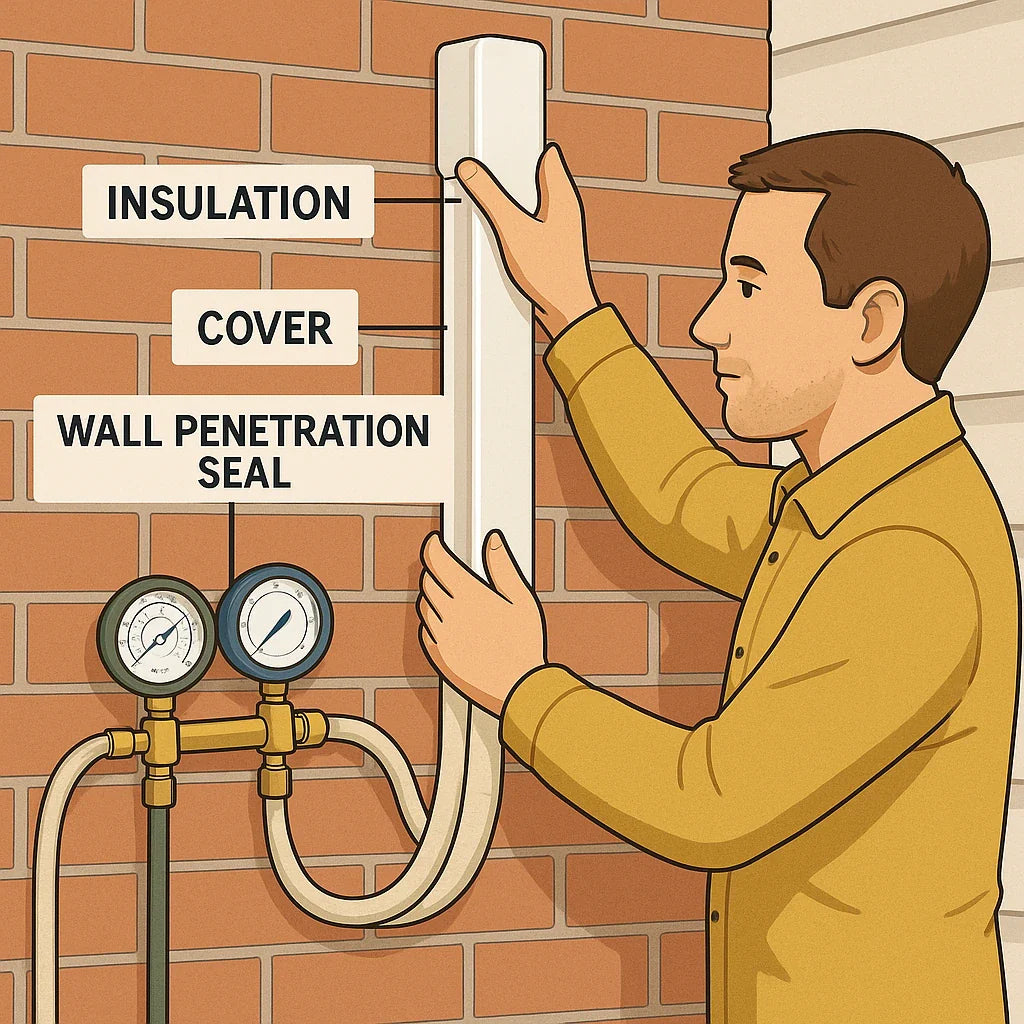When you install a mini-split heat pump, most of your attention goes to the indoor unit, the outdoor condenser, and making sure everything’s running efficiently. But there’s one piece of the system that’s just as important — yet often overlooked: the line sets.
These insulated copper pipes carry refrigerant between the indoor and outdoor units. If the insulation on these lines gets damaged by sunlight, weather, or pests, your heat pump will work harder, use more energy, and lose efficiency over time.
In this guide, I’ll walk you through how to choose the right insulation, protect it from the elements, and avoid common installation mistakes — so your system stays efficient for years.
📘 For a step-by-step overview of the entire installation process, see the Complete Guide to DIY Heat Pump Installation.
Why Insulation Matters for Outdoor Line Sets
Insulation on refrigerant lines serves two main purposes:
-
Preventing energy loss – Insulated lines keep refrigerant at the correct temperature as it travels between units. Without insulation, heat gain in summer or heat loss in winter forces your system to work harder.
-
Avoiding condensation – Bare lines can sweat in humid conditions, leading to water damage or mold growth on your home’s exterior.
According to the U.S. Department of Energy, poorly insulated refrigerant lines can reduce system efficiency and shorten the lifespan of your compressor. In other words — this isn’t just about looks, it’s about performance and longevity.
Choosing the Right Insulation Material
Not all pipe insulation is created equal. For outdoor line sets, you need materials designed to handle UV rays, temperature swings, and moisture.
Foam Rubber (Elastomeric)
-
Flexible, easy to install, and resists cracking in cold weather.
-
Excellent UV resistance, making it ideal for long-term outdoor exposure.
-
Common brands include Armaflex and K-Flex.
Polyethylene Foam
-
More affordable than foam rubber but less UV resistant.
-
Works well if paired with a protective line set cover.
📘 Insulation & More explains that elastomeric foam insulation offers superior weather resistance, flexibility, and thermal performance compared to many alternatives — making it one of the best options for protecting HVAC line sets outdoors.
UV and Weather Resistance Are Non-Negotiable
Even the best foam insulation can break down under constant sun exposure, wind, and moisture. That’s why adding a UV-resistant jacket or a rigid cover over the insulation is a smart move — it prevents cracking, fading, and water damage.
📘 Angi notes that using a PVC or aluminum cover over foam insulation can significantly extend its lifespan, especially in harsh outdoor environments.
How to Protect Line Sets from Damage
Good insulation is the first step — but physical protection ensures your investment lasts.
Using Line Set Covers
-
PVC or powder-coated metal covers keep insulation safe from UV rays, pests, and mechanical damage.
-
They also improve curb appeal by concealing the foam.
Securing and Supporting Line Sets
-
Refrigerant lines should never sag or rest directly on the ground.
-
Use brackets, clamps, or stand-offs to maintain clearance and prevent vibration wear.
The HVAC School recommends using proper supports every 4–6 feet for horizontal runs and ensuring lines are not in contact with sharp edges or abrasive surfaces.
Additional Protective Measures
-
Wrap exposed sections with weatherproof tape.
-
Seal any wall penetration with caulk or expanding foam to keep out insects and rodents. The EPA has guidance on sealing home gaps to prevent pest intrusion.
Step-by-Step Outdoor Line Set Protection
Here’s a proven process I use when installing or upgrading mini-split line set insulation:
-
Inspect Existing Insulation – Look for cracks, gaps, or UV damage.
-
Remove Damaged Sections – Cut away any brittle or crumbling insulation.
-
Install New Outdoor-Rated Insulation – Choose foam rubber with UV protection.
-
Add a Protective Sleeve or Line Set Cover – Improves appearance and durability.
-
Secure with Brackets or Clamps – Keep lines stable to prevent wear.
-
Seal Wall Penetrations – Prevents pest entry and moisture intrusion.
Common Mistakes to Avoid
Even experienced DIYers can slip up on the small details. Avoid these:
-
Using indoor-only insulation outdoors – It will degrade in a single season.
-
Leaving gaps in insulation – Any exposed copper becomes a heat transfer point.
-
Skipping the line set cover – Foam alone won’t hold up to UV exposure.
-
Poor securing – Loose lines can rub, kink, or vibrate, causing refrigerant leaks.
Final Thoughts from Alex
If you’re going to spend the time and money installing a mini-split heat pump, don’t cut corners on protecting the line sets. A little extra effort now means:
-
Higher system efficiency
-
Fewer repairs
-
Longer equipment life
Treat the insulation like part of the system, not an afterthought. Check it during seasonal maintenance, replace it when it shows wear, and keep it protected from the elements.
Next up: Best Wall Locations for Indoor Mini-Split Units: Avoid These Mistakes — where I cover placement tips to prevent poor airflow and uneven comfort.
Alex Lane
Your Home Comfort Advocate







